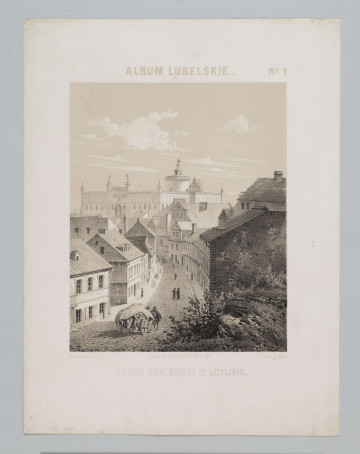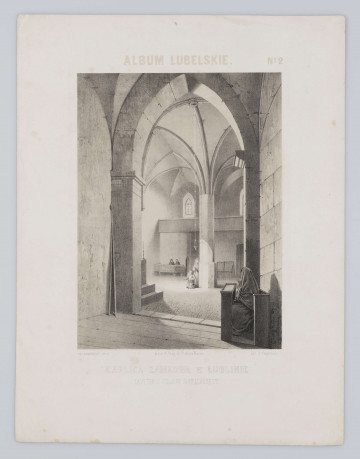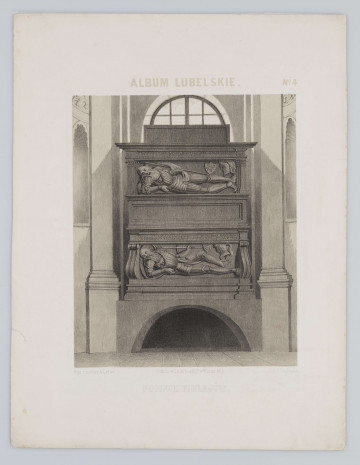
Royal Castle in Lublin
1857
National Museum in Lublin
Part of the collection: Lubliniana. Painting views of Lublin and the Lublin Region
The post-Bernardine church is situated on the edge of the cliff above the Bystrzyca valley, in the south-eastern part of the former Krakow suburb. The original temple of the Bernardines, who came from Krakow, was erected in the years 1460-1469 by councillors and city citizens. In the years 1470-1497 a Gothic brick church was built. During the great fire in 1557, Bernardine buildings burned down along with most of the Krakow suburbs. As a result of the collapse of the church vault, altars, paintings and other objects of worship were destroyed. The temple had been rebuilt by 1569, and became a late-gothic, three-nave hall with a facade and two towers. On June 29th, 1569, an important ceremony took place in this building – after the conclusion of the deliberations concerning the real union of Lithuania and Poland, which were held mainly in the royal castle, King Sigismund Augustus, surrounded by the senate, envoys from Poland, Lithuania, Prussia and others, and the numerous nobility and people, sang the hymn Te Deum laudamus, praising God for the successful course of the Lublin Sejm and the fortunate beginning of the union, which was officially concluded three days later.
In 1602, the church and the monastery burned down again. The reconstruction of the temple was completed in 1607. Then it became a late Renaissance basilica with three naves, a semi-circular chancel, a façade without towers and with decorations in the style of the so-called Lublin Renaissance. In later times, the church was often renovated. In the 17th and 18th centuries, chapels were added, but these were later eliminated. One of the most important ones was the chapel of the Assumption of the Blessed Virgin Mary, known as the royal chapel, restored by Marek Sobieski, the Lublin voivode, and his grandson, King Jan III. In its basement there were the graves of the Sobieskis, important donors of the monastery. After the death of Jan III, in the Easter period of 1699, the king’s sons, Jakub, Aleksander and Konstanty, came to the Bernardines of Lublin, and here they divided their father’s inheritance. Then and there, Prince Jakub, while participating in the Holy Thursday service, with humility and piety completed the ceremony of washing the feet of the poor.
In the 19th century, the church underwent renovation; in 1827 it received a classicist façade, transformed again in the years 1858-1860.
The Bernardine Order existed in Lublin until 1864. After a tsarist decree, its building became a parish church.
Renata Bartnik
Author / creator
Dimensions
cały obiekt: height: 31,1 cm, width: 24,2 cm
Object type
graphics
Technique
lithography
Material
paper
Creation time / dating
Creation / finding place
Owner
The National Museum in Lublin
Identification number
Location / status

1857
National Museum in Lublin

1857
National Museum in Lublin

1857
National Museum in Lublin
DISCOVER this TOPIC
National Museum in Lublin
DISCOVER this PATH
Educational path